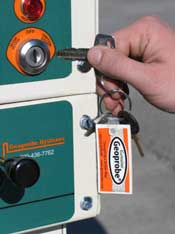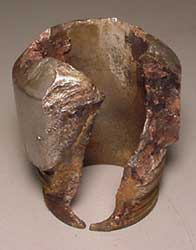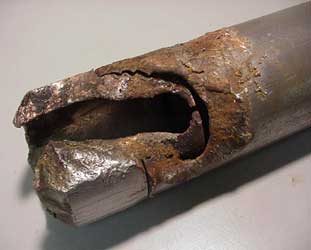Safety First

Warning Message
It’s important that everyone working close to heavy equipment keep their safety and the safety of those around them a priority so everyone goes home at night safe and sound. Geoprobe Systems® doesn’t take safety lightly.
Drilling rig safety is a chief consideration in the design and testing of all Geoprobe® direct push machines. While deliberate measures have been taken to remove the possibility of operator injury, our goal is that everyone exercise care whenever working with our machines.
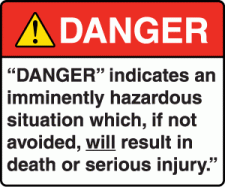
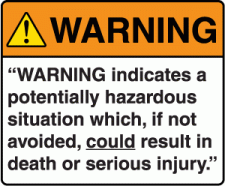
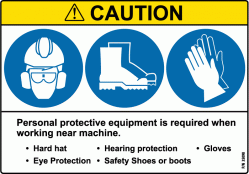
When you’re preparing to leave for a job in the morning, you make sure your equipment is stocked with the right tooling, such as the correct sized liners and samplers. It’s also important that field personnel are equipped to safely work through the day using standard safety gear, such as steel-toed boots and head, ear, and eye protection, in addition to protective clothing and/or breathing apparatus when conditions warrant.
Before starting your Geoprobe® machine, be aware of your surroundings. Check specifically for underground utilities before pushing tools in the ground.
During the machine training process, Geoprobe Systems® stresses three important drilling safety precautions prior to starting up the machine:
- Read all safety tips in the Owner’s Manual.
- Untrained personnel must be assisted by a qualified instructor.
- ALWAYS know the location of buried or underground utilities and services BEFORE pushing tools at any job site.
Individual graphics contain the signal words DANGER, WARNING, or CAUTION as illustrated above. Usage of these terms is to be consistent with the American National Standard Institute’s ANSI Z535.4 - 2007 American National Standard for Product Safety Signs and Labels.

The signal word selected for each graphic is determined by the seriousness level of the identified possible hazard. Beginning with the greatest severity, DANGER is followed in order of declining severity by WARNING and CAUTION. More information regarding the specific threat level of each signal word is given in the example graphics shown above right.
Every Geoprobe® machine sold is accompanied by an Owner’s Manual which includes an entire section on safety. Although owner’s manuals are looked upon as a pain (no matter what piece of equipment they accompany!), that’s where you and your staff will find the basic safe operating principles of Geoprobe® machines.

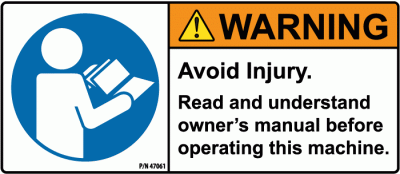
Why is it important to check underground utilities? |
This meltdown could have been a serious tragedy for the probe machine operator. A main power line was missed during the underground utility investigations, but wasn’t missed by this Macro-Core® sampler! The cable was encountered about 5 feet below the surface, and luckily, no one was injured. The actual size of the power line was unknown, but the line was being fed from one plant building to another, and was fed from a distribution panel to a 2000 amp, 3-phase, sub-panel. The arching did not trip a breaker ... it just arched/melted the sampler.
|
Be safe at your job. Accidents happen, but don’t overlook details that put you or your personnel in danger. Replacement copies of your machine’s owner’s manual can be ordered through Customer Service at 1-800-436-7762.
Track-mounted Drilling Rig Safety:
- Refer to the Kubota Diesel Engine Operator's Manual for all engine-related safety instructions before operating the Geoprobe® track-mounted machine.
- Heed all CAUTION, WARNING, and DANGER decals posted on the machine.
- Operators must wear OSHA-approved steel-toed shoes and keep feet clear of probe foot.
- Operators must wear OSHA-approved safety glasses at all times during the operation of this machine.
- Operators must wear hearing protection. OSHA-approved hearing protection for sound levels exceeding 85 dba is recommended.
- The Emergency Kill switch button on the control panel will immediately shut off the engine when pushed. Familiarize yourself with the location of this button before operating the machine.
- Ensure that everyone is clear of all moving parts before starting the engine.
- Check that both outriggers are fully raised before attempting to drive the unit.
- Do not drive the machine with the probe cylinder or winch mast extended. This practice could result in equipment damage and/or personal injury from contact with overhead objects such as power lines.
- The unit should only be driven using the remote control box. The steering levers located on the machine are for positioning only. Do not attempt to drive using the levers on the machine as this requires the operator to walk too close to the tracks while the vehicle is in motion.
- Do not attempt to drive the unit on slopes of more than 20°. Always drive straight up or down steep grades. Avoid sideslopes whenever possible.
- When maneuvering the unit in close quarters, lower engine speed to provide more precise control of the track assemblies.
- A track-mounted machine is generally transported on a trailer. Use special caution when loading the unit with wet ramps as it is significantly easier for the tracks to slip under such conditions.
- When operating the unit on sloped surfaces, always position the unit parallel with the slope. This provides the greatest degree of stability and will limit shifting during probing or augering operations. Position the track-mounted machine with the control panel upslope whenever possible so the machine will roll away from the operator if it becomes unstable and moves unexpectedly.
- Do not extend the outriggers such that the tracks are raised off of the ground more than one or two inches. Raising the tracks several inches off of the ground surface decreases the stability of the machine and provides no operational advantage.
- Designate one person to operate the machine while probing or augering. This will avoid injuries from having someone unexpectedly engage the machine controls while another person is working near moving parts.
- Operators must stand to the control side of the machine, clear of the probe foot and derrick, while operating the controls. Never reach across the probe assembly to manipulate the machine controls.
- Never place your hands on top of the tool string while raising or lowering the GH60 hammer.
- Never move the probe assembly (swing, extend, fold, etc.) or operate the tracks while anyone is in physical contact with the tool string.
- Use caution when probing on loose or soft surfaces. Reduced weight on the tracks may allow the unit to shift or slide under such conditions.
- Limit the rate at which the GH60 hammer is lowered while advancing the tool string to avoid raising the probe foot more than approximately 6 inches off of the ground surface.
- Never raise the machine foot more than a few inches from the ground surface with the probe cylinder and/or winch mast fully extended. If the foot must be raised significantly, first lower the hammer and winch.
- Always place the machine foot firmly on the ground when pulling tools from the subsurface.
- In the event of a problem, the operator should release all control levers. The spring-loaded levers will automatically return to the neutral position and machine operation will cease.
- Rotating parts can cause serious injuries. Shut off the engine before attempting to clean or service the unit.
- Do not make modifications or add attachments to this machine which are not approved by Geoprobe Systems®.
- Do not wear loose clothing while operating this machine. Severe injury will result if clothing becomes entangled in moving parts.
- Avoid hydraulic fluid leaks. Pressurized fluid may be injected into the skin resulting in serious bodily injury. In the event of an accident, seek medical attention immediately.
Truck-mounted Drilling Rig Safety:
- Always set the carrier vehicle parking brake and shut off the engine before exiting the cab. Refer to the carrier vehicle owner's manual for additional safety guidelines.
- Heed all CAUTION, WARNING, and DANGER decals posted on the machine.
- Operators must wear OSHA-approved steel-toed shoes and keep feet clear of probe foot.
- Operators must wear OSHA-approved safety glasses at all times during the operation of this machine.
- Operators must wear hearing protection. OSHA-approved hearing protection for sound levels exceeding 85 dba is recommended.
- The Emergency Kill switch button on the control panel will immediately shut off the engine when pushed. Familiarize yourself with the location of this button before operating the machine.
- Ensure that everyone is clear of all moving parts before starting the engine.
- Do not drive the machine with the probe cylinder or winch mast extended. This practice could result in equipment damage and/or personal injury from contact with overhead objects such as power lines.
- When operating the unit on sloped surfaces, always position the unit parallel with the slope. This provides the greatest degree of stability and will limit shifting during probing or augering operations. Position the machine with the control panel upslope whenever possible so the machine will roll away from the operator if it becomes unstable and moves unexpectedly.
- Designate one person to operate the machine while probing or augering. This will avoid injuries from having someone unexpectedly engage the machine controls while another person is working near moving parts.
- Operators must stand to the control side of the machine, clear of the probe foot and derrick, while operating the controls. Never reach across the probe assembly to manipulate the machine controls.
- Never place your hands on top of the tool string while raising or lowering the GH60 hammer.
- Never move the probe assembly (swing, extend, fold, etc.) while anyone is in physical contact with the tool string.
- Use caution when probing on loose or soft surfaces. Reduced weight on the rear wheels may allow the carrier vehicle to shift or slide under such conditions.
- Limit the rate at which the GH60 hammer is lowered while advancing the tool string to avoid raising the probe foot more than approximately 6 inches off of the ground surface.
- Never raise the machine foot more than a few inches from the ground surface with the probe cylinder and/or winch mast fully extended. If the foot must be raised significantly, first lower the hammer and winch.
- Always place the machine foot firmly on the ground when pulling tools from the subsurface.
- In the event of a problem, the operator should release all control levers. The spring-loaded levers will automatically return to the neutral position and machine operation will cease.
- Rotating parts can cause serious injuries. Shut off the engine before attempting to clean or service the unit.
- Do not make modifications or add attachments to this machine which are not approved by Geoprobe Systems®.
- Do not wear loose clothing while operating this machine. Severe injury will result if clothing becomes entangled in moving parts.
- Avoid hydraulic fluid leaks. Pressurized fluid may be injected into the skin resulting in serious bodily injury. In the event of an accident, seek medical attention immediately.
It’s important that everyone working close to heavy equipment keep their safety and the safety of those around them a priority so everyone goes home at night safe and sound. Geoprobe Systems® doesn’t take safety lightly.
Drilling rig safety is a chief consideration in the design and testing of all Geoprobe® direct push machines. While deliberate measures have been taken to remove the possibility of operator injury, our goal is that everyone exercise care whenever working with our machines.



When you’re preparing to leave for a job in the morning, you make sure your equipment is stocked with the right tooling, such as the correct sized liners and samplers. It’s also important that field personnel are equipped to safely work through the day using standard safety gear, such as steel-toed boots and head, ear, and eye protection, in addition to protective clothing and/or breathing apparatus when conditions warrant.
Before starting your Geoprobe® machine, be aware of your surroundings. Check specifically for underground utilities before pushing tools in the ground.
During the machine training process, Geoprobe Systems® stresses three important drilling safety precautions prior to starting up the machine:
- Read all safety tips in the Owner’s Manual.
- Untrained personnel must be assisted by a qualified instructor.
- ALWAYS know the location of buried or underground utilities and services BEFORE pushing tools at any job site.
Individual graphics contain the signal words DANGER, WARNING, or CAUTION as illustrated above. Usage of these terms is to be consistent with the American National Standard Institute’s ANSI Z535.4 - 2007 American National Standard for Product Safety Signs and Labels.

The signal word selected for each graphic is determined by the seriousness level of the identified possible hazard. Beginning with the greatest severity, DANGER is followed in order of declining severity by WARNING and CAUTION. More information regarding the specific threat level of each signal word is given in the example graphics shown above right.
Every Geoprobe® machine sold is accompanied by an Owner’s Manual which includes an entire section on safety. Although owner’s manuals are looked upon as a pain (no matter what piece of equipment they accompany!), that’s where you and your staff will find the basic safe operating principles of Geoprobe® machines.


Why is it important to check underground utilities? |
This meltdown could have been a serious tragedy for the probe machine operator. A main power line was missed during the underground utility investigations, but wasn’t missed by this Macro-Core® sampler! The cable was encountered about 5 feet below the surface, and luckily, no one was injured. The actual size of the power line was unknown, but the line was being fed from one plant building to another, and was fed from a distribution panel to a 2000 amp, 3-phase, sub-panel. The arching did not trip a breaker ... it just arched/melted the sampler.
|
Be safe at your job. Accidents happen, but don’t overlook details that put you or your personnel in danger. Replacement copies of your machine’s owner’s manual can be ordered through Customer Service at 1-800-436-7762.
Track-mounted Drilling Rig Safety:
- Refer to the Kubota Diesel Engine Operator's Manual for all engine-related safety instructions before operating the Geoprobe® track-mounted machine.
- Heed all CAUTION, WARNING, and DANGER decals posted on the machine.
- Operators must wear OSHA-approved steel-toed shoes and keep feet clear of probe foot.
- Operators must wear OSHA-approved safety glasses at all times during the operation of this machine.
- Operators must wear hearing protection. OSHA-approved hearing protection for sound levels exceeding 85 dba is recommended.
- The Emergency Kill switch button on the control panel will immediately shut off the engine when pushed. Familiarize yourself with the location of this button before operating the machine.
- Ensure that everyone is clear of all moving parts before starting the engine.
- Check that both outriggers are fully raised before attempting to drive the unit.
- Do not drive the machine with the probe cylinder or winch mast extended. This practice could result in equipment damage and/or personal injury from contact with overhead objects such as power lines.
- The unit should only be driven using the remote control box. The steering levers located on the machine are for positioning only. Do not attempt to drive using the levers on the machine as this requires the operator to walk too close to the tracks while the vehicle is in motion.
- Do not attempt to drive the unit on slopes of more than 20°. Always drive straight up or down steep grades. Avoid sideslopes whenever possible.
- When maneuvering the unit in close quarters, lower engine speed to provide more precise control of the track assemblies.
- A track-mounted machine is generally transported on a trailer. Use special caution when loading the unit with wet ramps as it is significantly easier for the tracks to slip under such conditions.
- When operating the unit on sloped surfaces, always position the unit parallel with the slope. This provides the greatest degree of stability and will limit shifting during probing or augering operations. Position the track-mounted machine with the control panel upslope whenever possible so the machine will roll away from the operator if it becomes unstable and moves unexpectedly.
- Do not extend the outriggers such that the tracks are raised off of the ground more than one or two inches. Raising the tracks several inches off of the ground surface decreases the stability of the machine and provides no operational advantage.
- Designate one person to operate the machine while probing or augering. This will avoid injuries from having someone unexpectedly engage the machine controls while another person is working near moving parts.
- Operators must stand to the control side of the machine, clear of the probe foot and derrick, while operating the controls. Never reach across the probe assembly to manipulate the machine controls.
- Never place your hands on top of the tool string while raising or lowering the GH60 hammer.
- Never move the probe assembly (swing, extend, fold, etc.) or operate the tracks while anyone is in physical contact with the tool string.
- Use caution when probing on loose or soft surfaces. Reduced weight on the tracks may allow the unit to shift or slide under such conditions.
- Limit the rate at which the GH60 hammer is lowered while advancing the tool string to avoid raising the probe foot more than approximately 6 inches off of the ground surface.
- Never raise the machine foot more than a few inches from the ground surface with the probe cylinder and/or winch mast fully extended. If the foot must be raised significantly, first lower the hammer and winch.
- Always place the machine foot firmly on the ground when pulling tools from the subsurface.
- In the event of a problem, the operator should release all control levers. The spring-loaded levers will automatically return to the neutral position and machine operation will cease.
- Rotating parts can cause serious injuries. Shut off the engine before attempting to clean or service the unit.
- Do not make modifications or add attachments to this machine which are not approved by Geoprobe Systems®.
- Do not wear loose clothing while operating this machine. Severe injury will result if clothing becomes entangled in moving parts.
- Avoid hydraulic fluid leaks. Pressurized fluid may be injected into the skin resulting in serious bodily injury. In the event of an accident, seek medical attention immediately.
Truck-mounted Drilling Rig Safety:
- Always set the carrier vehicle parking brake and shut off the engine before exiting the cab. Refer to the carrier vehicle owner's manual for additional safety guidelines.
- Heed all CAUTION, WARNING, and DANGER decals posted on the machine.
- Operators must wear OSHA-approved steel-toed shoes and keep feet clear of probe foot.
- Operators must wear OSHA-approved safety glasses at all times during the operation of this machine.
- Operators must wear hearing protection. OSHA-approved hearing protection for sound levels exceeding 85 dba is recommended.
- The Emergency Kill switch button on the control panel will immediately shut off the engine when pushed. Familiarize yourself with the location of this button before operating the machine.
- Ensure that everyone is clear of all moving parts before starting the engine.
- Do not drive the machine with the probe cylinder or winch mast extended. This practice could result in equipment damage and/or personal injury from contact with overhead objects such as power lines.
- When operating the unit on sloped surfaces, always position the unit parallel with the slope. This provides the greatest degree of stability and will limit shifting during probing or augering operations. Position the machine with the control panel upslope whenever possible so the machine will roll away from the operator if it becomes unstable and moves unexpectedly.
- Designate one person to operate the machine while probing or augering. This will avoid injuries from having someone unexpectedly engage the machine controls while another person is working near moving parts.
- Operators must stand to the control side of the machine, clear of the probe foot and derrick, while operating the controls. Never reach across the probe assembly to manipulate the machine controls.
- Never place your hands on top of the tool string while raising or lowering the GH60 hammer.
- Never move the probe assembly (swing, extend, fold, etc.) while anyone is in physical contact with the tool string.
- Use caution when probing on loose or soft surfaces. Reduced weight on the rear wheels may allow the carrier vehicle to shift or slide under such conditions.
- Limit the rate at which the GH60 hammer is lowered while advancing the tool string to avoid raising the probe foot more than approximately 6 inches off of the ground surface.
- Never raise the machine foot more than a few inches from the ground surface with the probe cylinder and/or winch mast fully extended. If the foot must be raised significantly, first lower the hammer and winch.
- Always place the machine foot firmly on the ground when pulling tools from the subsurface.
- In the event of a problem, the operator should release all control levers. The spring-loaded levers will automatically return to the neutral position and machine operation will cease.
- Rotating parts can cause serious injuries. Shut off the engine before attempting to clean or service the unit.
- Do not make modifications or add attachments to this machine which are not approved by Geoprobe Systems®.
- Do not wear loose clothing while operating this machine. Severe injury will result if clothing becomes entangled in moving parts.
- Avoid hydraulic fluid leaks. Pressurized fluid may be injected into the skin resulting in serious bodily injury. In the event of an accident, seek medical attention immediately.
Service Knowledgebase Index
Contact Us
1835 Wall Street
Salina, Kansas 67401
Phone: (785) 825-1842
Photo Gallery

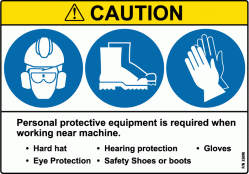
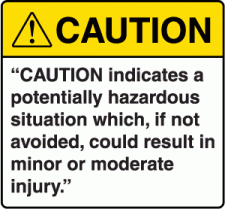

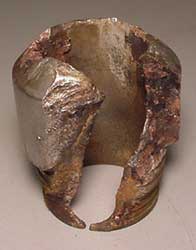
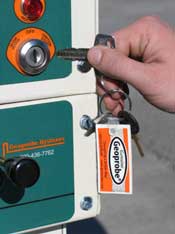
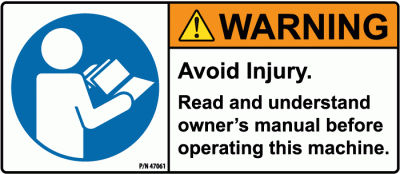
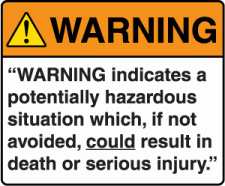
Service Locations
Kansas Service Center - Salina, KS
1835 Wall Street • Salina, Kansas 67401
785-825-1842Just one mile west of I-135 and an hour and half north of Wichita or two and half hours west of Kansas City, the drill rig service team keeps customers in the field through telephone service support or in shop repairs.
Southeast Service Center - Ocala, FL
5801 SW 6th Place • Ocala, Florida 34474
352-854-1566Just one mile west of I-75 and an hour northwest of Orlando, drillers have come to rely on the drill rig service team with double-digit years of hands-on experience servicing any rig for helpful answers or intensive rig fixes.
East Coast Service Center - Oxford, PA
468 Limestone Rd • Oxford, PA 19363
610-467-1750Just 30 minutes off of I-95, an hour west of Philadelphia, and two hours southwest of Newark, New Jersey. Rely on our team for refurbishments, repairs, and aftermarket upgrades for any rig.
North Carolina Service Center - Hickory, NC
2515 US Highway 70 SW • Hickory, NC 28602
828-998-0977Just 5 minutes off I-40 and an hour northwest of Charlotte, the drill rig service team provides support ranging from routine maintenance to intensive repairs for any rig.


